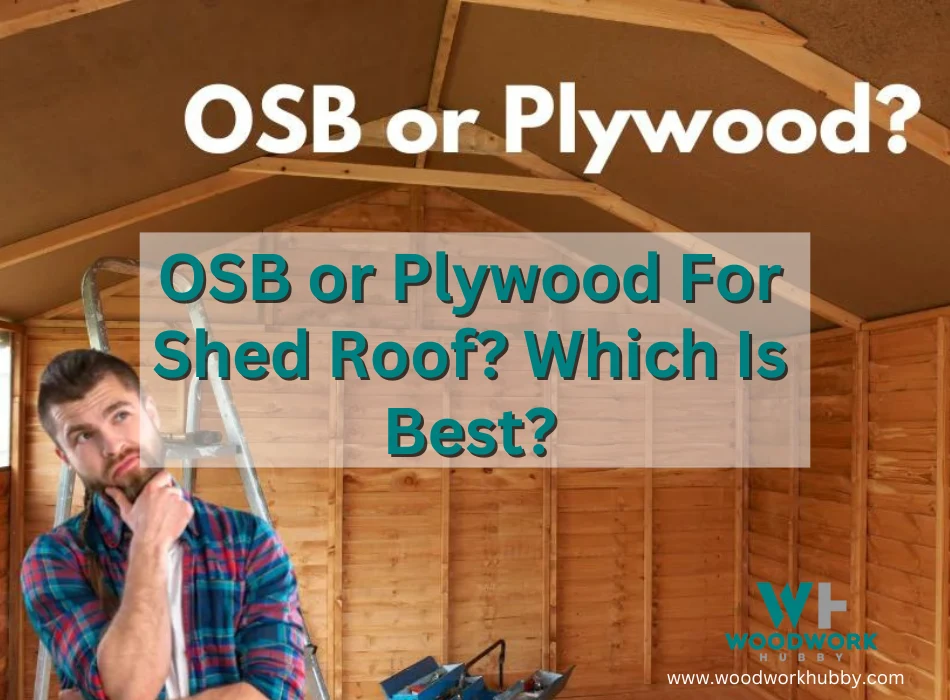Making a shed out of plywood is straightforward once you get the framing down. Once you’re done setting up the plywood walls, you have to finish the roof. I was in this same situation last month when I extended my shed. I did wonder which is the best material for the shed roof, plywood, or OSB? Here is what I found.
It is better to use OSB for the shed roof instead of regular plywood. But if you want to use plywood, you need to make sure it is 5/8 inches (16mm) thick and is exterior grade. Otherwise, it will be weaker than the average OSB.
In this article, you will learn everything you need to know about your shed roofing options. It will deal mainly with roof sheathing, but any underlayment material can also survive on the outside as long as it is exterior grade. For the most part, we will focus on plywood and OSB. By the end, you will know which one is best for your budget, shed scale, and project lifespan.
What Kind of Plywood Should I Use for a Shed Roof?
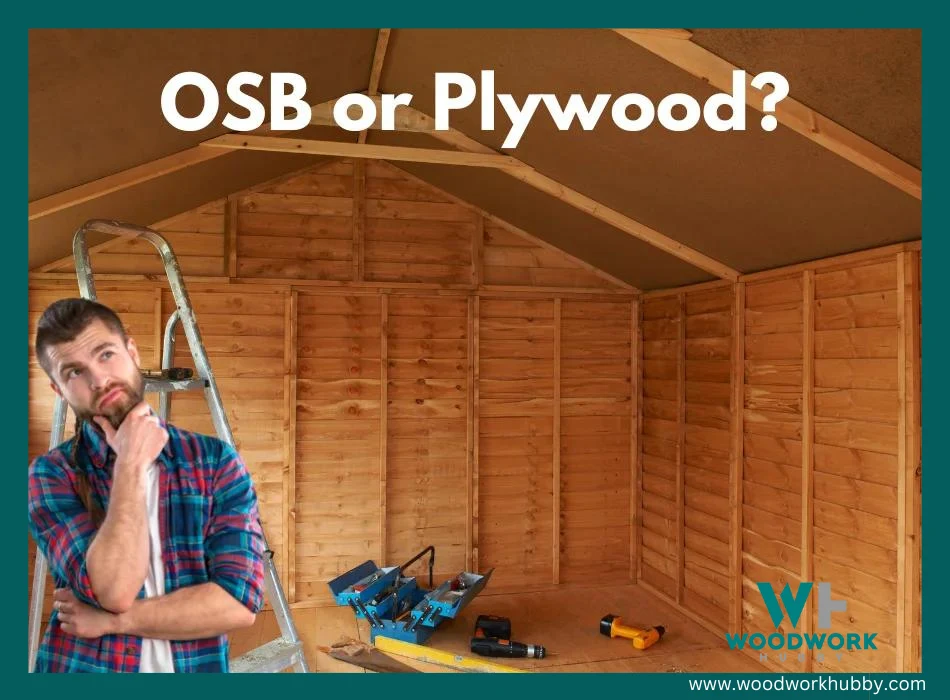
You might be considering a specific type of plywood for your shed roof, but it is possible that an alternative material might be much better for your project.
I’m not saying you should switch away from plywood sheathing. You need to know what properties a material must have to be the right fit for a shed roof. Here are the properties required for shed roof material.
Sturdiness
If you don’t want your shed roof to give the moment anything falls on it, you need a sturdy material. You might not stand on your shed roof, but if it is made from a thin sheet of plywood, it can cave in a hailstorm. The thickness requirements of the roof might tempt some woodworkers to choose OSB.
But OSB is weaker than equivalent plywood, which is why using it can be worse. OSB makes for a good roof sheath but not exterior roof material. Plywood that is as thick as an average OSB board is good enough for most shed roofs.
Waterproof
Note that this isn’t the same as ‘water resistant.’ Almost all plywood except the underlayment sheets is water resistant to an extent. But you need waterproof plywood because of the roof’s water exposure risk.
Read here what happened when my plywood got wet.
Regardless of whether you use plywood as a roof interior or exterior, it will be exposed to water due to rainfall or humidity. As long as you cover your plywood sheets in a waterproof primer or paint, this material demand can be checked off from the requirement list.
Heat-resistant
This is the last material property required for a shed roof, and it is almost optional. A material that expands or contracts too easily (like untreated wood) cannot be used for a shed roof. Fortunately, both plywood and OSB are heat-resistant to an extent.
Plywood Properties Against Shed Roof Demand
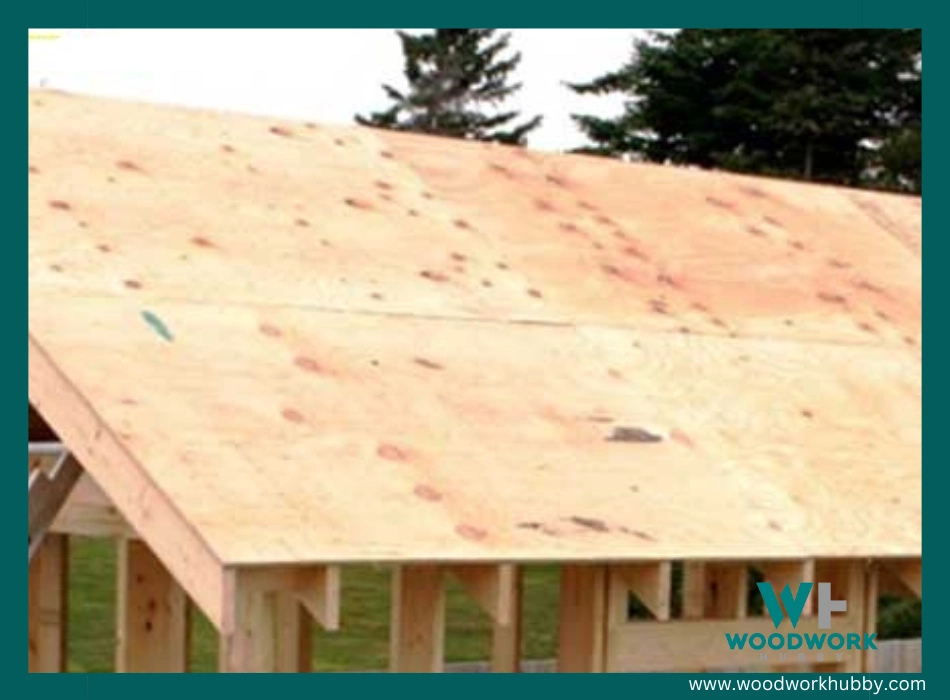
Now that you know that a shed roof material must be sturdy, waterproof, and heat-resistant, let’s look at how an average plywood board fares against these requirements.
- Plywood sturdiness – Is reliable for lightweight objects but may not stand up to a high-velocity impact like a hailstorm.
- Plywood waterproofing – Plywood of all kinds can be made waterproof with a coat of marine-grade paint or primer.
- Plywood heat resistant – Average plywood is fairly weatherproof but can’t survive extreme climates where winters are too cold and summers too hot.
The Type of Plywood That Works for a Shed Roof
The best plywood for a roof shed is a 5/8″ thick (16mm) CDX board. This is construction-grade (sturdy) and exterior-rated (weatherproof). It should be waterproofed and covered with a roof sheet for longevity. Small sheds can have a plywood roof exterior, but the main use of plywood should be to support the overlaying sheet.
Can You Use Plywood Instead of OSB for the Roof?
Plywood vs. OSB becomes a tricky question because there are types of plywood that are worse than OSB and a specific variety that is far better than OSB at sheathing and underlying anything, including roofs.
Shed roofs use both of these materials, but each one has its own advantages. In short, if you prefer using plywood instead of OSB for the roof, you can use it but must be ready to pay extra for thicker plywood.
To clarify this, let’s look at the pros and cons of both these options. Neither is inherently superior, by the way. I have used both for different shed projects. As long as you know what to expect, you won’t be disappointed.
Pros of Using Plywood
- It is stronger than OSB (when adjusted for thickness).
- It is fairly water-resistant and weatherproof to an extent.
- It is usually flat
Cons of Using Plywood
- To get plywood thick enough to be used for a roof, you need to pay more than you would pay for OSB.
Pros of Using OSB
- The average OSB board is stronger than the average plywood sheet.
- OSB is cheaper than plywood of equal thickness
Cons of Using OSB
- OSB can bend to impact and break under weight quicker than plywood of equivalent thickness.
While I was researching the differences between plywood and OSB, I also found out which material is the top pick for attic or subfloors. Be sure to check it out!
Video showing roof sheathing and what is used
The Verdict
You can use plywood instead of OSB for the roof as long as the plywood is thick enough and sufficiently weatherproofed and waterproofed. However, you can’t use regular plywood for a roof if you want the roof to last.
Ultimately, regular plywood comes out as the worst choice among the three options that are OSB, construction-grade thick plywood, and regular plywood. Here’s the breakdown of my verdict.
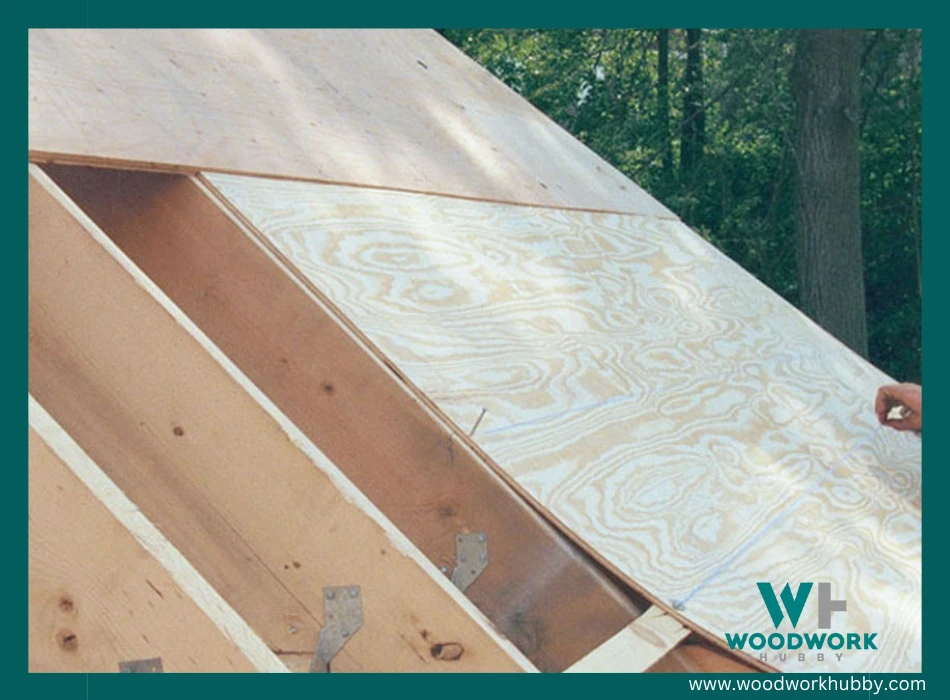
If money isn’t a factor, then the best option is construction-grade plywood that is as thick as a regular OSB board. Regular OSB is the second-best choice. And standard plywood is the least preferable option.
In case you consider just the budget without accounting for effectiveness, then regular plywood is the cheapest option, followed by OSB. The most expensive option is 5/8″ thick (16mm) plywood, which also happens to be the strongest.
Finally, if you balance budget-friendliness with effectiveness, then OSB comes out on top. It is a material I often use, especially when I know that the roof cover is sufficiently waterproof and impact-resistant.
Video explaining if OSB or Plywood is bets for your roof
What Wood Is Best for a Shed Roof?
We have already established the desirable traits of shed roof materials. When looking for wood to finish a shed roof, the question is which wood is sturdy as well as resists weather and water. The latter two can be handled with wood treatment. Properly finished and waterproofed wood from any lumber can resist water and heat. But sturdiness is inherent and varies by wood source.
Wood options for finishing a roof revolve around shingles for the most part. These can be crafted from cedar, oak, or redwood. Where oak and redwood are the expensive but long-lasting options (similar to 5/8″ (16mm) plywood underlayment), cedar is cheap but still gets the job done (just like standard OSB).
The difficulty of installing wood shingles, in my estimation, is also worth considering. I found it quite challenging for the first five or so times I tried to build a shed. And though I didn’t call in someone to install them for me, I should probably have done that. I wasted too many weekends trying to do it myself.
If you rate your construction-tier woodworking skills anywhere below 7/10, you should look for easier roof-finishing solutions or make your peace with bringing a professional to install the shingles.
There are 6 materials aside from wood that you can use for the top layer of your shed roof.
| Shed Roof Material | Lifespan (estimated) | Pro(s) | Con(s) |
|---|---|---|---|
| Rolled Roof (Roof Roll) | 6 – 12 years | It is easy to install and fairly affordable. It costs less money than wood shingles. | A roof roll is not aesthetic, and the outcome is not as visually pleasing. |
| Asphalt Shingles | 20 years | Asphalt shingles are durable and quite long-lasting for their price. | It cannot stand up to high-velocity winds. The shingles can also become mildew breeding grounds. |
| Metal Roof | 50 – 100 years | This is a material category with a wide range of options in prices and durability. Most of the material is lightweight. | Hard to repair and install. |
| Tile Roofing | 100 years | One of the longest-lasting options. It is more than 4 times as durable as wood. | It can be quite expensive. |
| Wood Shingles | 15 – 25 years | Durable against impact and beautiful to look at. | Not naturally waterproof. Require a slope to sit without incurring water damage. This makes them harder to install than most roof finishes. |
| Rubber Sheet Roofing | 25 – 55 years | Eco-friendly and long-lasting. | Not as stylish as other options and can require professional help. |
| Polycarbonate Panel Roofing | 10 – 20 years | Lightweight and can be installed with ease. | Not visually appealing and doesn’t resist scratches. |
What Thickness of Plywood Should I Use for Shed Roof?
You should use 5/8 inch (16mm) thick plywood for a shed roof as this is the optimum thickness for material sturdiness. However, depending on the durability of your roof finish, you can also use plywood that is 3/8 inches (9.5mm) thick.
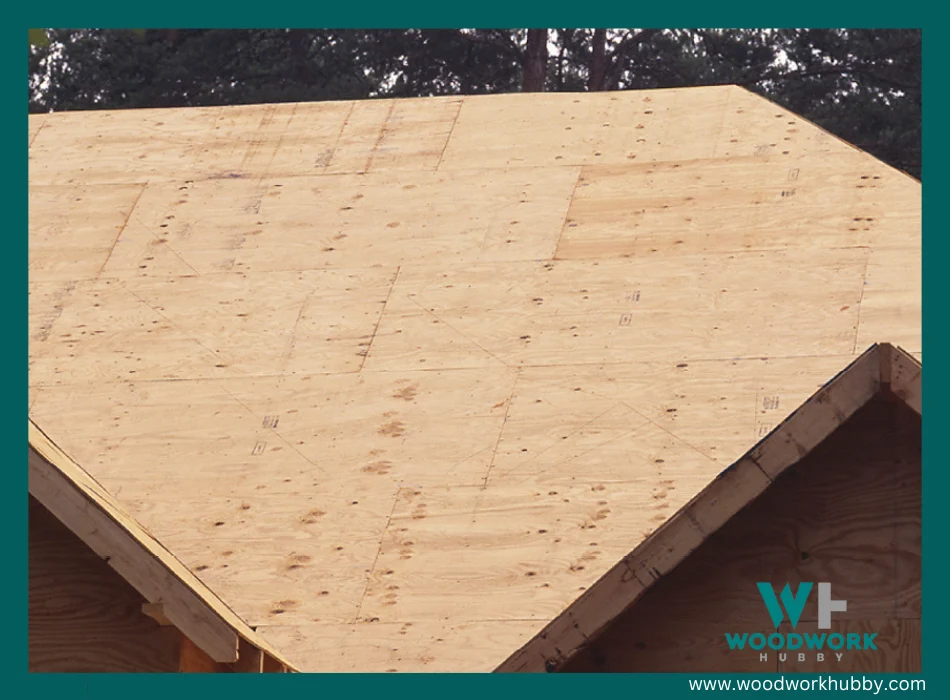
Plywood thickness range for shed roofs ranges from 1/2-inch (12mm) thickness to 5/8-inch (16mm) thickness, with three plywood depths commonly available. Let’s look at each one in detail.
- 1/2-inch plywood – This option is slightly weaker than the average OSB but can be used under a durable shed roof finish. It costs the least, given that thickness is a major pricing factor in plywood, so it makes for the perfect finish for a small-scale shed.
- 3/8-inch plywood – This thickness sets plywood on par with the average OSB. Even though this roofing material is not as thick as OSB, it is strong enough for a 10-year span, provided that it is topped with durable material. In my opinion, plywood this thick works for most sheds.
- 5/8-inch plywood – If you’re skeptical of plywood but still want to use it, then this is the thickness you should opt for. It is stronger than OSB and allows you to use a relatively ‘softer’ finish for the roof.
The thickness of plywood matters to the extent that the roof is vulnerable. It helps offset said vulnerability. But for the most part, experts insist on thicker plywood because the average craftsman makes the mistake of using leftover plywood sheets for plywood roofs.
And that’s a big mistake because strength is supposed to be the deciding factor.
Why Is Shear Strength a Deciding Factor?
It is worth noting that strength and density are pivotal to shed roof material choice. That said, the ultimate deciding factor is the shear strength, especially when the shed roof is at a slope.
Shear strength is not the same as strength in general. It is the ability of a material to resist collapsing internally due to a sliding force. If a material’s top layer slides against its bottom layer when a vertical or horizontal force acts on it, it doesn’t have shear strength.
Shear strength is important in shed roof materials, especially when the roof is at a slope. Gravity acts as a sliding force on a sloped roof. As you might know, the higher you are off the ground, the stronger gravity acts on you. The top layer of a shed roof is higher off the ground and is under a higher force to move compared to the lower layers. This could cause an internal collapse.
If the roof sheath or finish doesn’t have shear strength, the roof can collapse under its own weight. Because the shed roof often has more than one layer and enough sliding force on each layer to cause internal collapse, shear strength can single-handedly predict the longevity of the roof.
Final Thoughts – OSB or Plywood For Shed Roof?
OSB and Plywood are both good for a shed roof but not equally good. Regular plywood boards should never be considered for the roof, while OSB can be taken as a default choice. Construction-grade plywood ranging from 3/8-inch thick to 5/8-inch thick is durable enough for shed roof support.

